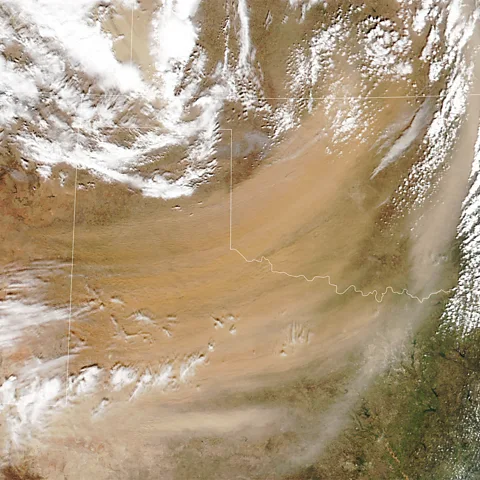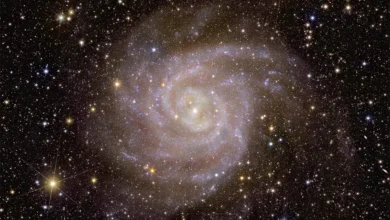‘Blood rain’ and diseases in the wind: Is the US prepared for deadly dust storms?

Dust storms are sweeping across the world, harming the health of millions of people. Now, scientists are racing to keep the dirt on the ground.
“I couldn’t see more than 50ft [15m] ahead,” says Dave Dubois. “It was a once-in-a-decade type of storm.”
In the spring of 2025, Dave Dubois, New Mexico State’s climatologist, drove to a weather station a few hours north from his home in Las Cruces, a town on the edge of the Chihuahuan Desert in southern New Mexico. On the way, he passed the blistering sand dunes of White Sands National Park and the UFO hotbed of Roswell. While performing routine maintenance on a monitoring sensor, a powerful cloud of dust descended. The lack of visibility led to a terrifying pile-up on a major interstate, causing several injuries.
In the first three months of 2025, New Mexico saw 50 dust storms, with 18 March being the dustiest day on record. Accompanied by wildfires and wind gusts in excess of 70mph (113 km/h), the skies darkened as the “dusty inferno” spread across America.
Despite being sandwiched between Arizona and Texas, two states prone to dust storms, New Mexico sees fewer high-intensity events. But when intense winds blow across land parched by 25 years of climate change-amplified drought, “you have the perfect recipe,” says Dubois.
The entire universe is made of dust, and it’s always travelling, from star to star, from the sky to Earth, from Africa to the Amazon – Daniel Tong
The Chihuahan Desert event was triggered by a mid-latitude cyclone, a low-pressure storm system responsible for most of the severe weather events experienced at the ground level. The fallout from this dust storm extended across a huge area, with dirty rain reportedly falling as far away as Wisconsin and North Carolina. The cyclone also spawned dust storms in the greater southwest and southern Plains regions, tornadoes in the Southeast, wildfires in the South, blizzards in the Midwest, and heavy rains in the Northeast.
Similar to other extreme weather events, dust and sand storms are becoming more common. These events, exacerbated by climate change, whip up soil, sand and other particulates into veils of dirt that are often disruptive and sometimes deadly. They impact us in surprising ways, from affecting our health through the spread of diseases, such as meningitis, to influencing nature’s water cycles, accelerating snowmelt by blanketing snow and causing it to thaw faster.

Dust storms are a natural – and to an extent, beneficial – part of the Earth’s climate and weather system, acting as a fertiliser for marine ecosystems. “The entire universe is made of dust, and it’s always travelling, from star to star, from the sky to Earth, from Africa to the Amazon,” says Daniel Tong, associate professor and atmospheric scientist at George Mason University in the US.
“People think that dust is just a part of the environment, part of the natural process,” says Tong. “But it has a greater impact on the economy and public health than some better-known weather and climate disasters.”
The race is now on to better understand these extreme weather events – and prevent some of them from happening.
The frequency of large dust storms in the southwestern US more than doubled from 1990 to 2011, according to a Noaa-led study. The same trend is apparent globally. The UN Environment Programme says in some areas desert dust increased twofold during the 20th Century.
Many such areas are in the Middle East and North Africa, home to the Arabian and Sahara deserts. Although sand storms are typically limited to desert regions, climate experts say these areas are expanding due to increasing drought and desertification. Scientists estimate that the Sahara Desert, for example, has expanded by up to 18% over the past century.
The reach of these events is enormous. When the warm, dry Harmattan winds that blow over West Africa and the southwestern Sahara pick up between November and April, they transport desert dust as far as the Caribbean on the other side of the Atlantic Ocean. Though the winds are a natural seasonal occurrence, desertification means they are able to move ever-growing quantities of dust. This past winter saw an increase, both in frequency and intensity, of Saharan dust storms across Europe and Latin America.

During a single week in April 2025, these storms left more than 1,000 people in central and southern Iraq suffering from respiratory issues. Similar storms that same month also prompted the cancellation of more than a thousand flights across both India and China. There were also cases of dust-pigmented “blood rain” in central Europe.
According to the World Health Organization, 330 million people are exposed to particles transported by wind every day. Dust comprises some 40% of the aerosols, or tiny airborne particles, present in the lowest layer of Earth’s atmosphere.
When people inhale these tiny grains, they can experience respiratory problems, such as asthma and pneumonia. Particulates can even cause severe heart and brain disease if they enter the bloodstream. A 2020 assessment linked a 15% increase in fine dust particle concentrations to a 24% increase in infant mortality rates across much of Africa.
Dust particles have also been found to carry diseases. In Sub-Saharan Africa’s so-called “meningitis belt”, which stretches from Senegal to Ethiopia, researchers have linked outbreaks of the disease’s most dangerous form, a bacterial brain infection, with dusty and dry conditions.
The mystery of ‘valley fever’
In the US, Tong and other researchers have also linked cases of “valley fever”, an infection caused by a soil-dwelling fungus, to wind-borne dust particles. The fungus is most common to the southwestern US though it also exists in parts of Mexico as well as Central and South America. Exposure can cause symptoms of pneumonia. There are, on average, 10,000-20,000 reported cases of valley fever, and 200 deaths from the disease, in the US annually.
Scientists consider valley fever something of a mystery. “Previously, we thought it only lived in dry climates like Arizona, but a few years ago, it was found in the state of Washington,” says Tong. “We don’t know how widespread the fungus is, all the ways it’s transmitted, or who is more susceptible.”
In January, Tong and colleagues at the University of Texas at El Paso and the US Department of Agriculture, published a study that described the enormous economic toll of dust and wind storms. In compiling the cost across sectors such as agriculture and transportation, the researchers found that these events cost Americans $154bn (£115.5bn) each year.
“We were surprised to find that dust storms are actually more costly than other so-called billion-dollar climate disasters,” says Tong. He highlighted the impact that dust can have on solar panels and wind turbines due to the fact that workers must frequently remove build-ups of grime from these installations. The paper by Tong and his colleagues also cited dust storms’ economic impact on healthcare, estimating that valley fever alone results in about $2.7bn (£2bn) a year in medical costs.










